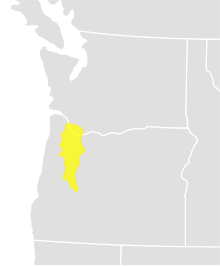| Gray-tailed vole | |
|---|---|
| Scientific classification | |
| Domain: | Eukaryota |
| Kingdom: | Animalia |
| Phylum: | Chordata |
| Class: | Mammalia |
| Order: | Rodentia |
| Family: | Cricetidae |
| Subfamily: | Arvicolinae |
| Genus: | Microtus |
| Subgenus: | Pitymys |
| Species: | M. canicaudus
|
| Binomial name | |
| Microtus canicaudus | |

| |
| Distribution of the gray-tailed vole | |
The gray-tailed vole (Microtus canicaudus) also known as the gray-tailed meadow vole or gray-tailed meadow mouse, is a rodent in the genus Microtus (small-eared "meadow voles") of the family Cricetidae. Voles are small mammals, and this species lies roughly in the middle of their size range. First collected in 1895, it is endemic to the Willamette Valley, Oregon, and Clark County, Washington, in the Pacific Northwest region of North America. Historically, they were found in the prairie areas of the Valley and, though many of these areas have been converted for agricultural purposes, these animals remain common. For reasons that remain unclear, vole population densities in any area may fluctuate widely from season to season and year to year. They are preyed upon by owls, hawks, and carnivorous mammals, and their parasites include fleas and ticks. These voles build burrows and complex tunnel networks, which they sometimes share with other burrowing animals. Relatively little is known about their behavior in the wild, because they are elusive and unlikely to enter traps.
